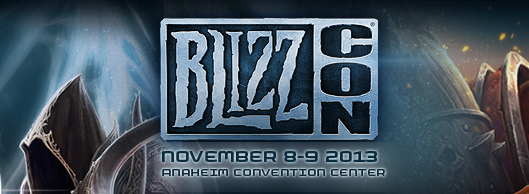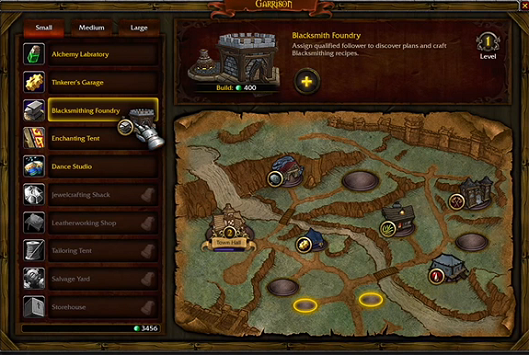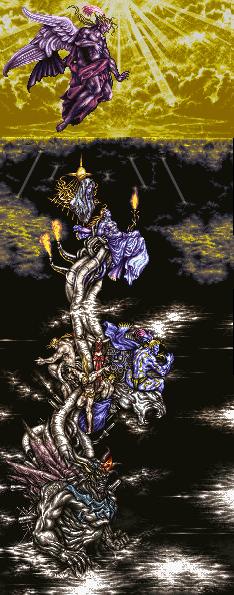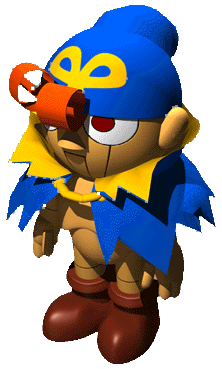
After a one year hiatus, BlizzCon is back. As I watched the opening ceremonies and subsequent World of Warcraft panel yesterday, I couldn’t help but draw parallels to another RPG powerhouse all but forgotten in the western world today: Squaresoft. The series of marketing failures that sent Square spiraling towards bankruptcy in the early 2000s felt eerily close at hand as Blizzard Entertainment unrolled one new project announcement after another yesterday in Anaheim.
Square’s troubles from a western perspective began in 1999. They had, prior to that year, released a handful of non-RPG titles in North America–I remember purchasing shmup Einhänder and enjoying Kenichiro Fukui’s soundtrack if nothing else–but these were Easter eggs not marketed to Square’s traditional fan base. In 1999, Square ported and pushed Ehrgeiz. It was a fighting game marketed specifically for RPG fans, incorporating popular Square franchise characters such as Sephiroth and Cloud Strife, and it was the first Square release in North America that I knew about and did not buy. I thought the game was a really cool idea at the time, but that didn’t change my fundamental disinterest in fighting games.
Next came Final Fantasy VIII. The game was definitely a short term marketing success, but it divided Square’s fan base unlike ever before, because it focused on aspects of the game that fans were traditionally disinterested in. It was the first Final Fantasy title to feature really impressive graphics, it introduced a highly developed card-based mini-game, it reenvisioned a lot of elements of the battle system, and it replaced a traditionally heroic cast with none-too-glamorous introverts. These features drew an audience, but they dulled the interest of loyal series fans who loved the epic tragedies and encompassing global struggle-styled plots of games gone by.
Last came The Spirits Within. Square decided to release a movie geared towards their newer fan base. They had no experience in this field, their diehard fans had already lost interest, and their new fans had no loyalty to the company. It flopped, really badly, and whatever the financial statements of Square Enix say, they never fully recovered their foothold in the western market. They found themselves desperately grasping to reel in a fan base that was too broad to take interest in any single product, until they ultimately faded into obscurity in every market. This can be seen in the fact that most Final Fantasy IX fans disliked Final Fantasy X and vice versa.
I say all of this because it is painfully relevant today. Here are two obvious reasons:
BLIZZARD ANNOUNCED A FIGHTING GAME
This isn’t nearly as misguided as Ehrgeiz. As I understand it, Heroes of the Storm will be styled after DotA, not traditional fighters. (The BlizzCon feed for HotS is hopelessly lagging on me, so I can’t confirm much.) But the idea of duking it out with your favorite characters from Blizzard’s three major franchises is only going to succeed if the gameplay drastically outclasses other games of its genre. They aren’t going to draw fans by letting you play as Kerrigan or Thrall, because most Blizzard loyalists are not convinced by the company’s character development. I would also argue that, following the massive hype and disappointment of Diablo III, Blizzard fans aren’t going to be very compelled by a new title beyond their franchises of choice that is not a wholesale break from what we’re used to. Heroes of the Storm will be free, and that is a huge plus, but it is going to have to be really freakin good to make it off the ground. As was the case with Square’s Ehrgeiz, the franchise card isn’t going to hold much weight in this field of play.
BLIZZARD ANNOUNCED A MOVIE
Yes, Warcraft: The Movie is under production. More will be revealed about this project at 1pm PST Saturday on the Main Stage, but absolutely nothing good can possibly come of it. Like The Spirits Within for Final Fantasy, it will only interest a small portion of the Warcraft fan base and hardly anyone beyond. Blizzard has never been a promising plot engine, and their cinematics are hopelessly cliche. It’s not like there’s any precedent for failure along the console to cinema highway, but I give Blizzard’s shot at turning a profit here about one in zero.
WARLORDS OF DRAENOR OVERVIEW
Now, I’ve claimed that Blizzard does not keep fans based on plot and character development. Am I right? Well, I’ve certainly known WoW players who cared about the plot, but they form a minority in my experience. That’s not to say that I or any other WoW fan would not love to see a really awesome plot. It’s to say we won’t get one. This is something Blizzard is particularly bad at, and it’s not the reason we play their games. That is one of the reasons World of Warcraft: Warlords of Draenor concerns me. The hour and a half of feature coverage yesterday focused heavily on the game’s plot and characters. Blizzard staff went on at length about the progression forward from Mists of Pandaria and the various NPCs you will encounter. In a comically self-defeating slide, they summed it up like this:

That’s all the more a Blizzard plot has ever really amounted to, and it’s why no one cares. Looking beyond the attempted plot hype, what else does Warlords of Draenor have to offer?
SETTING
WoW 6.0 will take place in Outlands, utilizing another weak time-travel plot device to set the zone prior to its cataclysmic restructuring as experienced in The Burning Crusade. Shattrath will now be an independent Draenei city, and the alliance and horde will have their capitals in Shadowmoon Valley and western Blade’s Edge Mountains respectively. These will be known as Karabor for alliance and Bladspire Citadel for horde, and the Blade’s Edge Mountains themselves will not yet exist as such. Their memorable spikey peaks having formed during Draenor’s later destruction, they will be separated into a western, mountainous winter zone (Frostfire Ridge) and an eastern desert (Gorgrond). Shadowmoon Valley will here be a lush land of forests and meadows, not a desolate fel-ridden waste, and Karabor will be the site of what later becomes Black Temple. There will be seven zones in all: Nagrand, Shadowmoon Valley, Tanaan Jungle (Hellfire Penninsula), Talador (Terokkar Forest), Frostfire Ridge (western Blade’s Edge), Gorgrond (eastern Blade’s Edge), and a new zone–Spires of Arak. None of these seem, in my opinion, to offer much of a unique flavor. That is somewhat inevitable, since Outlands is not an unfamiliar world.
The world will loosely resemble Outlands, and like most WoW continents, it will form an image when viewed as a whole:

GARRISONS
Garrisons were described at BlizzCon as “the [Valley of the Four Winds] farm times one thousand“. A garrison is a full town which you can build inside any zone within Draenor, and which you can move from one location to the next. Like the farm, a garrison will involve setting actions into motion which will occur over night (anywhere from a few hours to a full week), but the payout will be much higher. You’ll gain NPC followers who quest and raid for you to bring home epic gear, you’ll be able to tap into other professions beyond your main ones, you can pick and choose what buildings are constructed (armory, stables, etc), and you’ll be able to customize the garrison’s appearance any way you like as it grows. You can even hang a boss’s head from your front gates!
Sounds pretty cool, right? I think it’s riddled with problems. First of all, Blizzard reps claim: “This isn’t a cottage in a far away instance corner that doesn’t actually exist in the world. This is your ability to actually build a base almost as you do in the RTS games, in the actual world, that you’ll be able to see as you fly through the zones. You’ll be able to see it as you go by it. You’ll be able to invite your friends to come and see it if you want to.”
That is horribly misleading. Under the current developmental scheme, your garrison will exist for you and you alone. It’s true, like they said, that it will be smack in the middle of any map you care to put it in, and that it will be visible from afar, but it will be entirely isolated from all other players. It is a solitary bastion in an MMO world. No one will be able to see it (unless you invite them, presumably to role play); no one will be able to attack it; no one will ever know it exists. As such, it’s not much different from the average farming game on your cellphone. The only real reward is the production payout, whatever that may be. Let’s look at a few:

You can choose which buildings to include.
Ok, but what are buildings good for? An inn and stables aside, all buildings in WoW are used almost exclusively for profession and class trainers. But at level 100 you won’t need a class trainer, and Mists of Pandaria drastically nerfed the amount of time and energy necessary to max out a profession, so much so that grinds which once took a month or upwards of 100k gold can now be accomplished in an evening for petty change. (I think that was an awesome improvement in MoP. Don’t get me wrong.) Unless Blizzard invent new uses for these buildings, they will have none. Or if they add such features as transmog, upgrading, and reforging, then Karabor and Bladespire Citadel will be ghost towns. The screen shot Blizzard offered showed the blacksmith being used to learn new patterns. If that’s anything like the daily leatherworking and tailoring pattern rewards in MoP, it will be pretty useless.
It allows access to mats/It farms for you while you’re offline.
What does it farm? Blizzard have still yet to introduce any sort of access to solid gear outside of raiding or valor/conquest points. If this gear isn’t up to par, it will be a waste of time. Does it farm mats? If it’s anything like the Valley of the Four Winds farm in MoP, this will be a completely useless feature unless the mats are BoP. There is a reason you only farm Motes of Harmony in MoP: non-binding general profession mats always have and always will be the domain of bot farmers. You might not like them, but your auction house could not exist without them. They are what make ore and herbs affordable on your server, and the farm system alternative to gathering in MoP has never paid out in time spent to profit earned.
It gives you access to professions you don’t have.
MoP’s profession grind nerf still necessitates six toons at 85 to max everything out, so this could definitely come in handy, but at what cost? The more Blizzard takes away from the auction house, the more inflation will rise.
You can win trophies, and hang your enemies heads upon pikes at the castle wall! Yarrrgh!
The first note I jotted down while watching this BlizzCon session was “wtf is the point of building a castle in an mmo that is not mmo?” That pretty well sums it up. The whole purpose of a trophy case is to brag to other people about your accomplishments.
The bottom line is this: Blizzard couldn’t have given every player in the game a Garrison that existed out there in the real, massive multiplayer world, because it would have been a spam-ridden nightmare. But they could have given one to say, every level 25 guild with at least 20 exclusive active accounts, and they could have taken this in all sorts of promising directions, ranging from pvp sieges to player-made home cities instead of another Shattrath or Dalaran. But they didn’t. Instead, we all get a bigger farm.
GRAPHICS
This is actually pretty sweet. Blizzard is making a massive graphic overhaul to all races in the game, and will now offer visuals competitive with new MMOs on the market.

BOOST TO 90
In an attempt to lure back old players, Blizzard if giving every account a free boost to level 90 for one toon at any level. This is a pretty nice deal, but it could have some unintended consequences. I for one will be employing it as that long-awaited character transfer I was always unwilling to pay money for. By-by dying low population server, hello Sargeras, Kil’jaeden, or Kel’Thuzad. Expect this feature to increase urban migration and server balance polarization.
CROSS-SERVER ITEMS
Blizzard is increasing the types of items that will be available cross-server. In addition to mounts and battle pets, you will now be able to access BoA leveling gear heirlooms on any toon, anywhere. It’s about damn time, I think. They are also making tabards and toys account wide, which is just silly.
DUNGEONS & RAIDS
Warlords of Draenor will launch with 7 dungeons and 2 raids containing a total of 16 raid bosses. Only 4 of the 7 dungeons will be available below level 100, for maximum alt leveling boredom. Upper Blackrock Spire (UBRS) is getting a remake, and the level 100-only dungeons will have non-heroic versions in order to “help players prepare for heroic mode”. … Since no one would voluntarily run non-heroic dungeons at level cap, I interpret this to mean “expect more tedious grinding before you are eligible for real gear.” The reason behind this move is incomprehensible, as no one who is unready for heroic dungeons for reasons other than gear is any less unready for regular dungeons. They are called “noobs”, or “nubs” in some dialects, they are typically too disinterested in the finer details of the game to ever figure it out, and they will be carried by my epic hunter deeps. NEED that agi ring my DK friend! It will definitely help boost you over 10k dps!
Raids are getting a fourth tier. There will now be LFR, Normal, Heroic, and Mythic. LFR through Heroic will all be available under the relatively new and quite successful flex raiding system, and Mythic will be 20-man only. While this all sounds like a fine idea to me, the Blizzard reps did show once again how out of tune they were with the game they developed when they explained flex’s utility: We’ve all been in that annoying situation where a few dps or a healer bail in LFR right before a boss pull and we have to reenter queue and wait, they said. Flex will scale the LFR boss down so we can pull anyway!
Well, no, we haven’t. In fact, that never, ever, ever happens. DPS and healers are replaced in LFR in a matter of seconds. There is a 60 minute long queue line of them ffs. Long waits before boss pulls happen because TANKS leave, and you can’t rescale for that.
PVP
Blizzard is bringing back a world pvp zone, and it’s going to be a 24/7 battle rather than a timed instance. They compared it to classic Alterac Valley, and I’m pretty stoked about that. Unfortunately but necessarily, this is going to be a cross-server zone. That means that you’ll never form a collaborative relationship with your team mates, probably, but with a ton of servers reaching 90:10 faction polarization these days, I for one see no viable alternative.
In the world of arena, Blizzard is creating a separate ladder system called Trial of Gladiators. These ladder fights will only be available at certain dates and times, and they, rather than regular arena queues, will determine season champions. This was supposedly developed to eliminate late-night pairing exploitation, which I wholly intended to get in on to knock out some of my arena achievements, but I’m all for it. One really cool thing is that they’re eliminating gear for the event. You will be given the same premade gear set when you roll in, regardless of your ilevel or resilience, so victory will depend entirely on skill and class balance.
ODDS AND ENDS
Blizzard focused on a number of additional changes that Warlords of Draenor will offer, and most of them are complete rubbish that ought to just be quietly implemented on the next routine patch update.
* Battleground progression information — Blizzard are basically integrating PVP DBM into the game proper. But I’ve got an addon for that.
* Random favorite mount summoning — This will be an option. But I’ve got an addon for that.
* Enhanced bag sorting options — You will now be able to control which bags particular types of loot fall into. But I’ve got an addon for that.
* Battleground scores — You will now be able to see a conglomerate score of your performance in a battleground, incorporating traditional stats such as hks and damage done along with your involvement in objection completions. I am not very confident about Blizzard’s capacity to rate my performance, especially considering there are multiple strategies for winning just about any bg. This is also potentially really dangerous, because they suggested that there might be rewards for high scores. Does this mean that, even if you already have the Cap Five X achievement in a bg, you’re still encouraged to spam the hell out of the flag instead of fighting around it for a shot at the prize?
* Quest items will no longer be stored in bags — Yay!
* You can craft with items in your bank, not just your bag — Yay!
* Item stack caps raised from 20 to 100 — Yay!
But I fear that the few positive changes here and there aren’t going to make a difference in the big picture. Blizzard announced WoW 6 this BlizzCon, as expected, but they had very little to show for it. Plot and characters aren’t what keep us playing this particular game, the Garrison system is a single player entity isolated within an MMO world, and almost every other new thing they emphasized was astoundingly petty. There will be modest improvements here and there–to bag space, to raiding opportunities, to free server migration–but in previous expansions these would be afterthoughts. A lot of interface changes amount to nothing more than addon incorporation, but the players who don’t use say, a battleground objective addon, are probably oblivious to battleground objectives in the first place. The most depressing announcement towards this end was the ADVENTURE GUIDE. This is a menu like the Dungeon Guide, but designed for inexperienced players who don’t have a clue what’s going on. It will tell you what zone you ought to be questing in, where you can go for better gear (a dungeon. a raid. mmhmm…), what battlegrounds are available at your level, and so on. Did it ever cross Blizzard’s mind that the people who can’t figure out the dungeon finder or pvp menus aren’t going to figure out the adventure guide either? Obviously not, because the emphasis once again seems to be “hand more fine details to the players who don’t care and won’t read them.” I’m not trying to insult anybody here. My wife’s been happily bouncing around Eastern Kingdoms leveling gnome locks to 40 for a year now. There are players who want to “win” to the capacity that WoW allows, and there are players who just enjoy a little pew pew before they go to bed and have zero interest in learning more. Last I visited Blasted Lands, there was not a sea of confused level 60s unable to figure out how to walk into the Outlands portal. So just who do Blizzard think they’re helping with these improvements?
Has Blizzard lost touch with their fan base? Mists of Pandaria does not lead me to believe so, but the showcase for Warlords of Draenor looks bleak. With little more than a dime-a-dozen farming mini-game and new zones, dungeons, and raids to offer, I don’t know what I’m supposed to be looking forward to here. I don’t need a new class or a new race to keep me entertained–I’ll be a dwarf hunter until the day I quit–but I need something. Whatever that thing will be, it wasn’t revealed at BlizzCon.
But enough being a Negative Nancy. I’m off to watch Jaedong whoop ass in the Starcraft II World Championship Series Finals. For the swarm!


